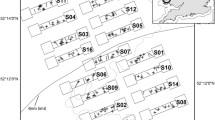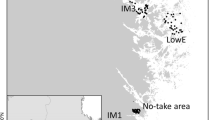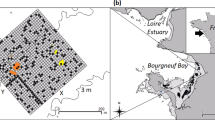Abstract
Around the globe, marine soft sediments on continental shelves are affected by bottom trawl fisheries. In this study, we explore the effect of this widespread anthropogenic disturbance on the species richness of a benthic ecosystem, along a gradient of bottom trawling intensities. We use data from 80 annually sampled benthic stations in the Dutch part of the North Sea, over a period of 6 years. Trawl disturbance intensity at each sampled location was reconstructed from satellite tracking of fishing vessels. Using a structural equation model, we studied how trawl disturbance intensity relates to benthic species richness, and how the relationship is mediated by total benthic biomass, primary productivity, water depth, and median sediment grain size. Our results show a negative relationship between trawling intensity and species richness. Richness is also negatively related to sediment grain size and primary productivity, and positively related to biomass. Further analysis of our data shows that the negative effects of trawling on richness are limited to relatively species-rich, deep areas with fine sediments. We find no effect of bottom trawling on species richness in shallow areas with coarse bottoms. These condition-dependent effects of trawling suggest that protection of benthic richness might best be achieved by reducing trawling intensity in a strategically chosen fraction of space.




Similar content being viewed by others
References
Abrams PA. 1995. Monotonic or unimodal diversity-productivity gradients: what does competition theory predict? Ecology 76:2019–27.
Adler PB, Seabloom EW, Borer ET, Hillebrand H, Hautier Y, Hector A, Harpole WS, O’Halloran LR, Grace JB, Anderson TM, Bakker JD, Biederman LA, Brown CS, Buckley YM, Calabrese LB, Chu C-J, Cleland EE, Collins SL, Cottingham KL, Crawley MJ, Damschen EI, Davies KF, DeCrappeo NM, Fay PA, Firn J, Frater P, Gasarch EI, Gruner DS, Hagenah N, Hille Ris Lambers J, Humphries H, Jin VL, Kay AD, Kirkman KP, Klein JA, Knops JMH, La Pierre KJ, Lambrinos JG, Li W, MacDougall AS, McCulley RL, Melbourne BA, Mitchell CE, Moore JL, Morgan JW, Mortensen B, Orrock JL, Prober SM, Pyke DA, Risch AC, Schuetz M, Smith MD, Stevens CJ, Sullivan LL, Wang G, Wragg PD, Wright JP, Yang LH. 2011. Productivity is a poor predictor of plant species richness. Science 333:1750–3.
Baretta JW, Ebenhöh W, Ruardij P. 1995. The European regional seas ecosystem model, a complex marine ecosystem model. Neth J Sea Res 33:233–46.
Beare D, Rijnsdorp AD, Blaesberg M, Damm U, Egekvist J, Fock H, Kloppmann M, Röckmann C, Schroeder A, Schulze T, Tulp I, Ulrich C, van Hal R, van Kooten T, Verweij M. 2013. Evaluating the effect of fishery closures: lessons learnt from the Plaice Box. J Sea Res 84:49–60.
Bergman MJN, Hup M. 1992. Direct effects of beam trawling on macrofauna in a sandy sediment in the southern North Sea. ICES J Mar Sci 49:5–11.
Bremner J. 2008. Species’ traits and ecological functioning in marine conservation and management. J Exp Mar Biol Ecol 366:37–47.
Collie JS, Hall SJ, Kaiser MJ, Poiner IR. 2000. A quantitative analysis of fishing impacts on shelf-sea benthos. J Anim Ecol 69:785–98.
Connel J. 1978. Diversity in tropical rain forests and coral reefs. Science 199:1302–10.
Cusens J, Wright SD, McBride PD, Gillman LN. 2012. What is the form of the productivity-animal-species-richness relationship? A critical review and meta-analysis. Ecology 93:2241–52.
Daan R, Mulder M. 2009. Monitoring the invertebrate benthic fauna in the Dutch sector of the North Sea 1991–2005: an overview NIOZ-Report.
Dauwe B, Herman PMJ, Heip CHR. 1998. Community structure and bioturbation potential of macrofauna at four North Sea stations with contrasting food supply. Mar Ecol Prog Ser 173:67–83.
Deltares. 2011. Map produced by Deltares, based on bathymetric data provided by the Netherlands Hydrographic Office of the Royal Netherlands Navy (Dutch Ministry of Defense) and Rijkswaterstaat Directorate North Sea (Dutch Ministry of Infrastructure and the Environment).
Diesing M, Stephens D, Aldridge J. 2013. A proposed method for assessing the extent of the seabed significantly affected by demersal fishing in the Greater North Sea. ICES J Mar Sci 70:1085–96.
Ebenhoh W, Baretta-Bekker JG, Baretta JW. 1997. The primary production module in the marine ecosystem model ERSEM II, with emphasis on the light forcing. J Sea Res 38:173–93.
Fox JW. 2013. The intermediate disturbance hypothesis should be abandoned. Trends Ecol Evol 28:86–92.
Gough L, Grace JB, Taylor KL. 1994. The relationship between species richness and community biomass: the importance of environmental variables. Oikos 70:271–9.
Grace JB. 2006. Structural equation modeling and natural systems. Cambridge, UK: Cambridge University Press.
Grace JB, Schoolmaster DR, Guntenspergen GR, Little AM, Mitchell BR, Miller KM, Schweiger EW. 2012. Guidelines for a graph-theoretic implementation of structural equation modeling. Ecosphere 3:art73.
Gray JS. 2002. Species richness of marine soft sediments. Mar Ecol Prog Ser 244:285–97.
Grime JP. 1973. Competitive exclusion in herbaceous vegetation. Nature 242:344–7.
Guo Q, Berry WL. 1998. Species richness and biomass: dissection of the hump-shaped relationships. Ecology 79:2555–9.
Hall SJ. 1994. Physical disturbance and marine benthic communities—life in unconsolidated sediments. Oceanogr Mar Biol 32:179–239.
Hall SJ, Gray SA, Hammett ZL. 2000. Biodiversity-productivity relations: an experimental evaluation of mechanisms. Oecologia 122:545–55.
Hiddink JG, Jennings S, Kaiser MJ, Queiros AM, Duplisea DE, Piet GJ. 2006. Cumulative impacts of seabed trawl disturbance on benthic biomass, production, and species richness in different habitats. Can J Fish Aquat Sci 63:721–36.
Hintzen NT, Piet GJ, Brunel T. 2010. Improved estimation of trawling tracks using cubic Hermite spline interpolation of position registration data. Fish Res 101:108–15.
Hintzen NT, Bastardie F, Beare D, Piet GJ, Ulrich C, Deporte N, Egekvist J, Degel H. 2012. VMStools: open-source software for the processing, analysis and visualisation of fisheries logbook and VMS data. Fish Res 115–116:31–43.
Hinz H, Prieto V, Kaiser MJ. 2009. Trawl disturbance on benthic communities: chronic effects and experimental predictions. Ecol Appl 19:761–73.
Hughes RA, Byrnes JE, Kimbro DL, Stachowicz JJ. 2007. Reciprocal relationships and potential feedbacks between biodiversity and disturbance. Ecol Lett 10:849–64.
Huston M. 1979. A general hypothesis of species diversity. Am Nat 113:81–101.
Huxham M, Roberts I, Bremner J. 2000. A field test of the intermediate disturbance hypothesis in the soft-bottom intertidal. Int Rev Hydrobiol 85:379–94.
Jennings S, Kaiser MJ. 1998. The effects of fishing on marine ecosystems. In: Blaxter JHS, Southward AJ, Tyler PA, Eds. Advances in marine biology. UK: Academic Press London. p 201–352.
Kaiser MJ. 1998. Significance of bottom-fishing disturbance. Conserv Biol 12:1230–5.
Kaiser MJ, Spencer BE. 1996. The effects of beam-trawl disturbance on infaunal communities in different habitats. J Anim Ecol 65:348–58.
Kaiser MJ, Collie JS, Hall SJ, Jennings S, Poiner IR. 2002. Modification of marine habitats by trawling activities: prognosis and solutions. Fish Fish 3:114–36.
Kaiser MJ, Clarke KR, Hinz H, Austen MCV, Somerfield PJ, Karakassis I. 2006. Global analysis of response and recovery of benthic biota to fishing. Mar Ecol Prog Ser 311:1–14.
Kondoh M. 2001. Unifying the relationships of species richness to productivity and disturbance. Proc R Soc B 268:269–71.
Mackey RL, Currie DJ. 2001. The diversity–disturbance relationship: is it generally strong and peaked? Ecology 82:3479–92.
Mittelbach GG, Steiner CF, Scheiner SM, Gross KL, Reynolds HL, Waide RB, Willig MR, Dodson SI, Gough L. 2001. What is the observed relationship between species richness and productivity? Ecology 82:2381–96.
Molinero A, Flos R. 1992. Influence of season on the feeding habits of the common sole Solea solea. Mar Biol 113:499–507.
Moore DRJ, Keddy PA. 1989. The relationship between species richness and standing crop in wetlands: the importance of scale. Vegetatio 79:99–106.
Oksanen L, Fretwell SD, Arruda J, Niemela P. 1981. Exploitation ecosystems in gradients of primary productivity. Am Nat 118:240–61.
Paine RT. 1966. Food web complexity and species diversity. Am Nat 100:65–75.
Pearson TH, Rosenberg R. 1978. Macrobenthic succession in relation to organic enrichment and pollution of the marine environment. Oceanogr Mar Biol Annu Rev 16:229–311.
Piet GJ, Hintzen NT. 2012. Indicators of fishing pressure and seafloor integrity. ICES J Mar Sci 69:1850–8.
Rijnsdorp AD, Vingerhoed B. 2001. Feeding of plaice Pleuronectes platessa (L.) and sole Solea solea (L.) in relation to the effects of bottom trawling. J Sea Res 45:219–29.
Rijnsdorp AD, Buys AM, Storbeck F, Visser EG. 1998. Micro-scale distribution of beam trawl effort in the southern North Sea between 1993 and 1996 in relation to the trawling frequency of the sea bed and the impact on benthic organisms. ICES J Mar Sci 55:403–19.
Rijnsdorp AD, Poos JJ, Quirijns FJ, HilleRisLambers R, De Wilde JW, Den Heijer WM. 2008. The arms race between fishers. J Sea Res 60:126–38.
Rijnsdorp AD, Poos JJ, Quirijns FJ. 2011. Spatial dimension and exploitation dynamics of local fishing grounds by fishers targeting several flatfish species. Can J Fish Aquat Sci 68:1064–76.
Rosseel Y. 2012. Lavaan: an R Package for structural equation modeling. J Stat Softw 48:1–36.
Seitz RD. 1998. Incorporation of soft-sediment systems into a model of marine benthic community regulation. Mar Freshw Res 49:817–26.
Shucksmith R, Hinz H, Bergmann M, Kaiser MJ. 2006. Evaluation of habitat use by adult plaice (Pleuronectes platessa L.) using underwater video survey techniques. J Sea Res 56:317–28.
Shurin JB, Borer ET, Seabloom EW, Anderson K, Blanchette CA, Broitman B, Cooper SD, Halpern BS. 2002. A cross-ecosystem comparison of the strength of trophic cascades. Ecol Lett 5:785–91.
Snelgrove PVR. 1999. Getting to the bottom of marine biodiversity: sedimentary habitats. Ocean bottoms are the most widespread habitat on Earth and support high biodiversity and key ecosystem services. Bioscience 49:129–38.
Sousa WP. 1984. The role of disturbance in natural communities. Annu Rev Ecol Syst 15:353–91.
Thrush SF, Pridmore RD, Bell RG, Cummings VJ, Dayton PK, Ford R, Grant J, Green MO, Hewitt JE, Hines AH, Hume TM, Lawrie SM, Legendre P, McArdle BH, Morrisey D, Schneider DC, Turner SJ, Walters RA, Whitlatch RB, Wilkinson MR. 1997. The sandflat habitat: scaling from experiments to conclusions. J Exp Mar Biol Ecol 216:1–9.
Tilman D, Pacala S. 1993. The maintenance of species richness in plant communities. In: Ricklefs RE, Schluter D, Eds. Species diversity in ecological communities. Chicago: University of Chicago Press. p 13–25.
van Denderen PD, van Kooten T, Rijnsdorp AD. 2013. When does fishing lead to more fish? Community consequences of bottom trawl fisheries in demersal food webs. Proc R Soc B 280:20131883.
Waide RB, Willig MR, Steiner CF, Mittelbach G, Gough L, Dodson SI, Juday GP, Parmenter R. 1999. The relationship between productivity and species richness. Annu Rev Ecol Syst 30:257–300.
Wilson WH. 1991. Competition and predation in marine soft-sediment communities. Annu Rev Ecol Syst 21:221–41.
Acknowledgments
We thank T. Essington and two anonymous reviewers for their helpful suggestions to improve the manuscript and S. de Valk and J. Cremer for their help in assembling the data. P. D. vD. wants to thank D. R. Schoolmaster Jr., H. Koike, and E. Wall for their contributions during the first analysis and L. McPhee for her contribution in the preparation of the manuscript. This research was partially supported through the policy support research programme (BO) of the Dutch Ministry of Economic Affairs to P. D. vD. and T. vK. and the FP7 project BENTHIS (312088) to N. T. H., A. D. R. and T. vK.
Author information
Authors and Affiliations
Corresponding author
Additional information
Author contributions
P.D.vD., A.D.R and T.vK conceived the study. N.T.H. contributed with trawl disturbance estimates; P.R. contributed with primary productivity estimates; P.D.vD. performed the research and together with T.vK. wrote the manuscript and all discussed results and commented the manuscript.
Electronic supplementary material
Below is the link to the electronic supplementary material.
Rights and permissions
About this article
Cite this article
van Denderen, P.D., Hintzen, N.T., Rijnsdorp, A.D. et al. Habitat-Specific Effects of Fishing Disturbance on Benthic Species Richness in Marine Soft Sediments. Ecosystems 17, 1216–1226 (2014). https://doi.org/10.1007/s10021-014-9789-x
Received:
Accepted:
Published:
Issue Date:
DOI: https://doi.org/10.1007/s10021-014-9789-x




